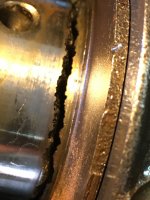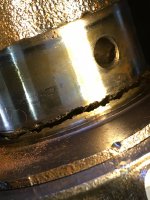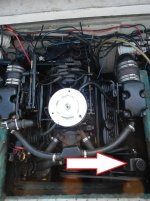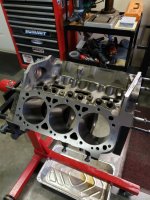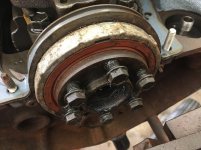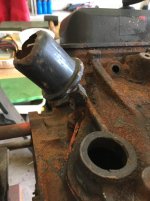Rivergator
Petty Officer 1st Class
- Joined
- May 7, 2013
- Messages
- 238
.....continued from "Engine Removal on 1988 Sylvan"
We had 2 nasty hurricanes in the last 3 months and I am just now caught up with cleaning up everything. 2 weeks ago I was finally able to start taking the engine apart and to my surprise, the engine looks very good inside. No visible deterioration or wear and tear. Compared to a car engine I would say this engine may have 25000-30000 miles on it, that’s how new and clean everything looks. Most of the damage is on the outside, mainly lots of rust, which damaged the dip stick tube, left side valve cover, timing chain cover, intake manifold, starter, alternator, carburetor, fuel pump. Of all the peripherals what were still salvageable was the power steering pump, distributor and the engine water pump. I just got through acid washing all the water passages on the 2 heads and the engine block. Next step will be a thorough inspection of the heads and valves and then I go on to do the same with all the pistons, piston rings etc. and a honing of all cylinders.
Today I started to remove the pistons and my worst fear came true. The crankshaft is broken (see pictures). I had this fear because when I tried to crank the shaft by hand it just didn’t feel right. What would cause the crank to brake? I think I can probably answer that myself. A sudden lock up of the outdrive and the cylinders that have just fired will force the pistons down on the crank which is no longer turning....and bang, something has got to give. There may be other reasons as well, but this is probably the most logical one I can think of. I haven’t even started on the out drive yet but I am afraid to look, probably busted gears inside. Well, that’s a new chapter. Right now I need to find a good crankshaft. Does anyone have one or knows somebody who has one. Again, my engine is a 1988 MerCruiser 4.3 ltr (w/o balance shaft). Btw, that is not my engine, but a picture of one like mine.
We had 2 nasty hurricanes in the last 3 months and I am just now caught up with cleaning up everything. 2 weeks ago I was finally able to start taking the engine apart and to my surprise, the engine looks very good inside. No visible deterioration or wear and tear. Compared to a car engine I would say this engine may have 25000-30000 miles on it, that’s how new and clean everything looks. Most of the damage is on the outside, mainly lots of rust, which damaged the dip stick tube, left side valve cover, timing chain cover, intake manifold, starter, alternator, carburetor, fuel pump. Of all the peripherals what were still salvageable was the power steering pump, distributor and the engine water pump. I just got through acid washing all the water passages on the 2 heads and the engine block. Next step will be a thorough inspection of the heads and valves and then I go on to do the same with all the pistons, piston rings etc. and a honing of all cylinders.
Today I started to remove the pistons and my worst fear came true. The crankshaft is broken (see pictures). I had this fear because when I tried to crank the shaft by hand it just didn’t feel right. What would cause the crank to brake? I think I can probably answer that myself. A sudden lock up of the outdrive and the cylinders that have just fired will force the pistons down on the crank which is no longer turning....and bang, something has got to give. There may be other reasons as well, but this is probably the most logical one I can think of. I haven’t even started on the out drive yet but I am afraid to look, probably busted gears inside. Well, that’s a new chapter. Right now I need to find a good crankshaft. Does anyone have one or knows somebody who has one. Again, my engine is a 1988 MerCruiser 4.3 ltr (w/o balance shaft). Btw, that is not my engine, but a picture of one like mine.
Attachments
Last edited:




















